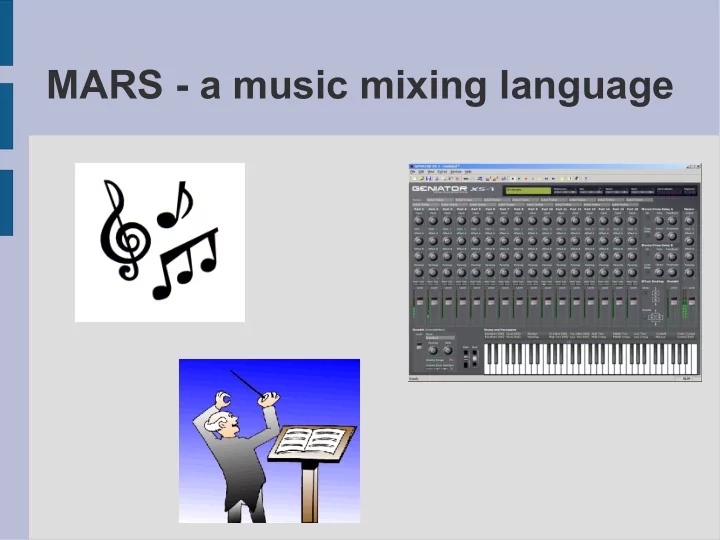

MARS - a music mixing language
Overview ● What's the point? – A lot of music is repetitive ● Mozart ● Britney Spears – Why not let a computer handle the repetition? ● predefined loops ● MARS language ● Creativity ● Problem with professional software? – too confusing! – grad students don't have any money :(
Overview ● Data Structures vs Music Compositions – Complex data structures ● Collection of primitives ● Executed in certain order or concurrently – Complex music composition ● Collection of music tracks or parts ● Played in certain order or concurrently
Overview ● Define music entities Composition – Composition ● Sections ● Groups ● Tracks Section A Section B ● Add behaviors Track 3 – Play – Delay Track 1 – Loop Group G1 Track 4 – Mix Track 2 – Volume control
Your first composition Everything is wrapped in a composition def composition HelloOpus track swapneel = “HelloWorld.wav” track ritika = “Nifty.wav” def section MainSection swapneel.play() ritika.play() mix(swapneel.play(), ritika.play()) end playOrder(MainSection) end
Your first composition ● def composition / end – Defines new composition – Each composition is its own file ● Like Java! – Compositions have ● Sections, groups, and tracks
Your first composition ● track swapneel = “HelloWorld.wav” – Tracks are the building block – sound files ● def section MainSection / end – Sections are defined subdivisions of a song – Used to represent Musical Form ● Mozart – A B A form ● Britney Spears - Intro, Bridge, Chorus – We only have one section here – More complex song, more repeated sections
Your first composition System Commands ● play(), play(double) – Plays a given track at that moment – Optional parameter to only play to certain portion ● mix(track, track..) – Mixes tracks at same time (super-impose) ● Mix on play command ● Many other advanced commands – fadeIn – setVolume – delay – getLength
Your first composition ● playOrder(section...) – Acts as a “main” for the composition – Will play defined sections in a certain order – Mandatory, even if there is only one section – Sections can be repeated, common for songs ● Demo song has 4 sections, played in this order: – Verse – Bridge – Chorus – Guitar Solo – Verse – Bridge – Chorus – Rap Ending
More advanced features ● For loops – The ability to loop tracks with traditional for loops ● Used to accomplish something on each iteration – (i.e. Volume change) ● Groups – Used to “Group” tracks ● Rhythm group consists of bass drum, cymbal, snare – Useful for coding group once, used repeatedly
Even More advanced features ● Conditionals – If statements, and If/Else statements – Used to only play under certain conditions ● Perhaps only every other iteration? ● Scope – Static scoping – def / end defines scope – Global scope ● Things not defined inside sections or groups
Implementation ● First half of process – Generate Java code from MARS (*.mars) composition
Implementation ● Second half of process – Generate executable Java composition – Interface with MARS Sound API ● Abstracted version of Java Sound API
Lessons Learned ● Unique language – Had a hard time defining semantics – Had a hard time understanding control flow ● Start with small subset of language – It is easy to overshoot features – Start small, then add...NOT the other way! ● Start earlier – Easy to put PLT as last priority. Not a good idea!
Summary ● Fun language – Creativity in language – Fun to test because of sound – Harder to test because of sound ● Makes life easier – Easy to repeat thing like sections and groups – Easy to iterate on your composition – Easy to see relationship between tracks/sections ● Not very practical – Very hard to “debug” a music language – You need a good ear and a lot of patience
Recommend
More recommend